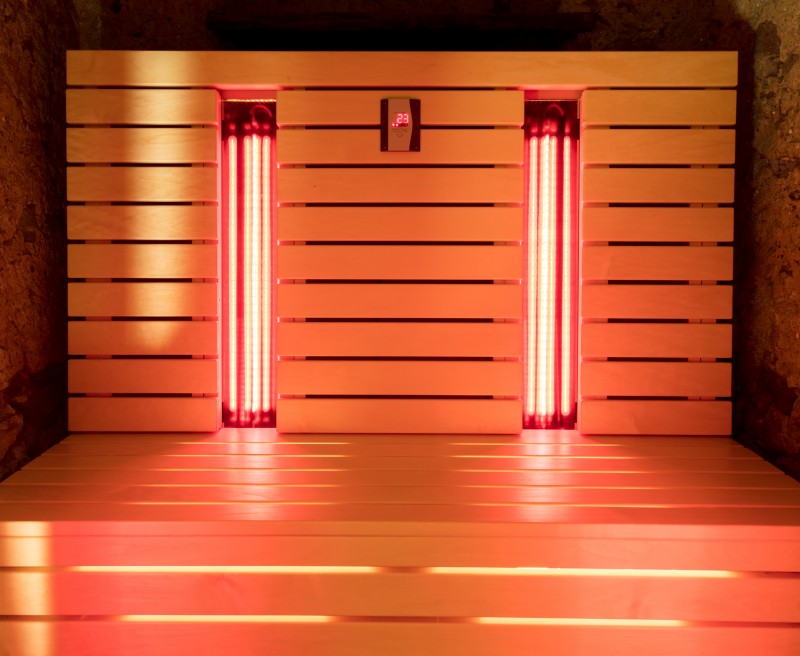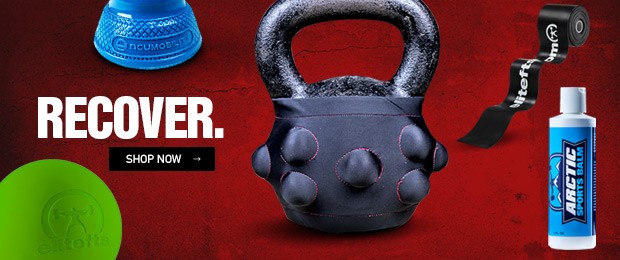
Lately, there has been a bunch of hype around infrared (IR) saunas. I was basically ignoring all of the hype until I was sitting in the car on the way to a birthday party one day and the driver turned to me and said, “Did you know that Planet Fitness has IR saunas?” The expression on my face was probably priceless, as I remember being so confused. How could a gym that has a lunk alarm for heavy deadlifting also have one of the newest recovery crazes? And, not to mention, it’s an expensive craze?! An IR sauna costs somewhere between 1,000-5,000 bucks!
RECENT: Training to Build New Neural Pathways
So, it got me wondering, are IR saunas really THAT beneficial? Do they truly have weight loss, detox, and anti-aging abilities? I honestly had no idea at that moment, but I could imagine how great it would be to experience a bunch of health benefits just from sitting in a fancy sauna. So, I decided to do a little research on IR saunas to see if they really live up to the current hype.
Premise
IR saunas differ from other saunas in how they generate heat. It’s crucial that you remember this. Why? Because it means that most sweating-related benefits of the IR sauna can also be achieved with conventional saunas. So, whereas traditional saunas generate heat in the form of steam and hot air, which warms the air, the IR sauna works by creating heat using infrared radiation. Thus, the heat produced by an IR sauna comes from within you. More specifically, when the IR light hits your skin, it causes an increase in your internal temperature and hence makes you hot and sweaty. And don’t worry, IR waves are considered to be pretty darn safe. If you don’t like the heat of a traditional sauna but like its sweaty side effects, the IR sauna might be a good idea for you. In an IR sauna, the level of heat to which you get exposed is less than that of a traditional sauna (50˚C-65˚C versus 85˚C-90˚C).
The Science to Support the Fluff
I won't lie; there isn’t much research out there on the effects of IR saunas and all of the benefits they supposedly have. Honestly, this isn’t super surprising because I can’t see the funding powers at play wanting to invest in studies looking at the benefits of these expensive heat boxes. Nonetheless, let’s talk about what we do know from the studies we do have.
In the context of acute weight loss, any sauna (not just the IR ones) will help you to lose weight. Specifically, you will lose weight in the form of water. So, yes, a sauna can lead to immediate weight loss, but it isn’t the fat loss you are likely after. For fat loss to occur, you need to create some kind of caloric deficit. Once that deficit (from a reduction in food intake or from more activity) is made, your body mobilizes the triglycerides stored in the fat cells. The triglycerides are then broken down into hydrogen, carbon, and oxygen while your body eats up the ATP generated in the process. These three byproducts (hydrogen, carbon, oxygen) are then ultimately eliminated as water vapor by breathing. Additionally, things like urination, sweating, and crying excrete the tiny amount of remaining fat from the triglycerides. Hence, for IR saunas to actually cause weight loss, a fat would have to be broken down for fuel prior to sweat and the release of triglyceride byproducts. Unfortunately, research has yet to show that IR saunas cause fat breakdown. Instead, they have shown that IR light, without a stimulus to promote the breakdown of fat (aka exercise), is unable to reduce fat mass1, 2. Only when combined with exercise has IR light been shown to be effective at reducing fat mass1, 2. This, of course, makes sense based on what we discussed above.
Image credit: Micha Klootwijk © 123rf.com
Concerning using these saunas to eliminate toxins, fat also hinders the practicality of the IR sauna’s application as a detoxification device. Although the process of pulling water out could be beneficial in terms of excreting toxins through your sweat, this cannot happen unless fat is also breaking down. Because the science hasn't shown that IR saunas induce fat breakdown or mobilization, it’s unlikely they cause detoxification. And why, you might ask? Because the largest storage place for toxins is fat cells, and these cells don’t just release toxins when the temperature increases; they have to be breaking down first. Thus, it’s unlikely (and unproven) that toxins are released by sitting in an IR sauna.
With that being said, it is clear that a cardiovascular demand is elicited in response to IR sauna-induced heat. More specifically, IR heat penetration induces increases in the heat rate, cardiac output, and vasodilation as the body attempts to return to thermoregulatory homeostatsis3, 4. Additionally, IR light has been shown to increase microcirculation5, blood flow5, and capillary density6 in rats and hamsters. Some believe that this response is comparable to moderately paced walking3, 4, but it’s important to note that that assumption fails to consider that the caloric expenditure required to move a body is not equivalent to sitting in a hot area and sweating. So, there may be cardiovascular benefits to using an IR sauna (or likely any sauna).
Other areas of research are limited in the context of IR sauna benefits. Studies have shown that IR sauna therapy can improve things like muscle aches and stiffness in people with arthritis or chronic pain7, 8. However, the evidence hasn’t held true in populations of people who lift. In fact, the findings from one study that looked at recovery, IR saunas, and lifting failed to show that IR saunas caused changes in the ability of the neuromuscular system to recover from lifting9. Hence, the science (currently) says that the IR sauna is unlikely to aid in speeding up recovery. However, I could see how heating up your muscles at a lower temperature than that of a regular sauna (heating in a traditional sauna allows your brain temperature to increase and can therefore hinder your neuromuscular abilities) would make them more pliable and hence make you feel better and less sore. But at this point, that’s more speculation than scientific proof.
So, good news for those who don’t want to shell out the cash for an IR sauna: As you can see, scientifically, the whole idea of IR sauna use for weight loss, detox, and recovery is much more driven by opinions that by actual scientific support.
What About the Hypothetical Workings?
There are a LOT of questionable claims out there that IR saunas will cause weight loss. At the same time, there is a whole lot of theoretical and scientific information to support how this could be true. As a scientist, I’ll indulge the hypothetical workings on how IR saunas could cause weight loss, which are derived from what we know about a similar type of light therapy called low-level laser light therapy/photobiomodulation. These Food and Drug Administration–approved modalities specifically use near-infrared (NIR) light. From the research on NIR therapies, we know a little bit about how this type of light/radiation augments metabolism. More specifically, we know that as NIR light penetrates the skin and enters cells, it’s absorbed by mitochondria and subsequently augments how they work in a way that causes a rapid increase in ATP production and oxygen consumption10, 11. It's important to note that this pertains to NIR but not far-infrared (FIR) light. With FIR light, water is the absorber, and with NIR, it's the cytochrome c oxidase unit of the mitochondrial respiratory chain. I won’t go into the molecular details of what would need to happen to the structure of membranes underlying nanostructured water layers for NIR and FIR to be the same. Instead, I’ll just tell you that they are different. Thus, for this metabolic shift to be true with both types of IR light, the disturbances to water layers and the subsequent effects would have to be comparable to those seen with NIR therapy12, 13. Regardless, even if they are similar, it’s still unclear with both types of IR light how long the shift persists post penetration and if the caloric demands of that shift are sufficient for inducing changes in whole-body metabolism in a way that is sufficient for inducing weight loss. Therefore, hypothetically, maybe IR saunas can alter your metabolism, but that’s yet to be supported by any studies.
So, what will actually happen as a result of IR sauna use (and what won’t probably happen)?
Likely:
- Your body temperature will increase.
- You will likely start sweating and have some minor water weight loss.
- Your heart rate will increase, as will blood circulation.
* Please note that these all happen in a regular sauna, too.
Unlikely:
- Fat loss
- Detox
- Improved neuromuscular performance
From where I’m standing, you don’t need a gym membership that allows you access to an IR sauna. These saunas appear to be much more fad than fantastic.
References
- Sene-Fiorese, M. et al. The potential of phototherapy to reduce body fat, insulin resistance and "metabolic inflexibility" related to obesity in women undergoing weight loss treatment. Lasers in surgery and medicine 47, 634-642 (2015).
- Aquino, A.E., Jr. et al. Low-level laser therapy (LLLT) combined with swimming training improved the lipid profile in rats fed with high-fat diet. Lasers in medical science 28, 1271-1280 (2013).
- Beever, R. Far-infrared saunas for treatment of cardiovascular risk factors: summary of published evidence. Canadian family physician Medecin de famille canadien 55, 691-696 (2009).
- Ikeda, Y. et al. Repeated sauna therapy increases arterial endothelial nitric oxide synthase expression and nitric oxide production in cardiomyopathic hamsters. Circulation journal : official journal of the Japanese Circulation Society 69, 722-729 (2005).
- Yu, S.Y. et al. Biological effect of far-infrared therapy on increasing skin microcirculation in rats. Photodermatology, photoimmunology & photomedicine 22, 78-86 (2006).
- Akasaki, Y. et al. Repeated thermal therapy up-regulates endothelial nitric oxide synthase and augments angiogenesis in a mouse model of hindlimb ischemia. Circulation journal : official journal of the Japanese Circulation Society 70, 463-470 (2006).
- Masuda, A., Koga, Y., Hattanmaru, M., Minagoe, S. & Tei, C. The effects of repeated thermal therapy for patients with chronic pain. Psychotherapy and psychosomatics 74, 288-294 (2005).
- Oosterveld, F.G. et al. Infrared sauna in patients with rheumatoid arthritis and ankylosing spondylitis. A pilot study showing good tolerance, short-term improvement of pain and stiffness, and a trend towards long-term beneficial effects. Clinical rheumatology 28, 29-34 (2009).
- Mero, A., Tornberg, J., Mantykoski, M. & Puurtinen, R. Effects of far-infrared sauna bathing on recovery from strength and endurance training sessions in men. SpringerPlus 4, 321 (2015).
- Chung, H. et al. The nuts and bolts of low-level laser (light) therapy. Annals of biomedical engineering 40, 516-533 (2012).
- Huang, Y.Y., Chen, A.C., Carroll, J.D. & Hamblin, M.R. Biphasic dose response in low level light therapy. Dose-response : a publication of International Hormesis Society 7, 358-383 (2009).
- Sommer, A.P., Caron, A. & Fecht, H.J. Tuning nanoscopic water layers on hydrophobic and hydrophilic surfaces with laser light. Langmuir : the ACS journal of surfaces and colloids 24, 635-636 (2008).
- Sommer, A.P., Zhu, D., Mester, A.R. & Forsterling, H.D. Pulsed laser light forces cancer cells to absorb anticancer drugs--the role of water in nanomedicine. Artificial cells, blood substitutes, and immobilization biotechnology 39, 169-173 (2011).












Sauna use associated with reduced risk of cardiac, all-cause mortality
https://www.sciencedaily.com/releases/2015/02/150223122602.htm
Compared with men who reported one sauna bathing session per week, the risk of SCD was 22 percent lower for 2 to 3 sauna bathing sessions per week and 63 percent lower for 4 to 7 sauna sessions per week. The risk of fatal CHD events was 23 percent lower for 2 to 3 bathing sessions per week and 48 percent lower for 4 to 7 sauna sessions per week compared to once a week. CVD death also was 27 percent lower for men who took saunas 2 to 3 times a week and 50 percent lower for men who were in the sauna 4 to 7 times a week compared with men who indulged just once per week. For all-cause mortality, sauna bathing 2 to 3 times per week was associated with a 24 percent lower risk and 4 to 7 times per week with a 40 percent reduction in risk compared to only one sauna session per week.
The amount of time spent in the sauna seemed to matter too. Compared with men who spent less than 11 minutes in the sauna, the risk of SCD was 7 percent lower for sauna sessions of 11 to 19 minutes and 52 percent less for sessions lasting more than 19 minutes. Similar associations were seen for fatal CHDs and fatal CVDs but not for all-cause mortality events.
"Further studies are warranted to establish the potential mechanism that links sauna bathing and cardiovascular health," the study concludes.
Editor's Note: Health Benefits of Sauna Bathing
In a related Editor's Note, Rita F. Redberg, M.D., of the University of California, San Francisco, and editor-in-chief of JAMA Internal Medicine, writes: "Although we do not know why the men who took saunas more frequently had greater longevity (whether it is the time spent in the hot room, the relaxation time, the leisure of a life that allows for more relaxation time or the camaraderie of the sauna), clearly time spent in the sauna is time well spent."
this is also loaded with interesting info:
https://www.youtube.com/watch?v=eWKBsh7YTXQ
Thank you for mentioning our studies.
Thanks for sharing this blog here with us.